On some living-history/reenactement events there is no sleeping area inside a building available. Since I do not want to always ask for a place in someone else tent I wanted to buy my own one. But which type should I buy?
Most of the time I will need this tent when I am alone or on smaller events. Therefore setting it up alone shouldn’t be too hard. Cone tents seem to be perfect for this use case. Therefore I was looking for sources of 13th century cone tents. But there are no remaining cone tents from the 13th century (I did not find any remains of original cone tent). But one can find a lot of pictures in medieval codices. I have collected some of them on my ppinterest page
The tents look mostly identical but differ in some details. On the following image one can see that pole could be lifted by attaching a rope at the top. Therefore a tent could be a lot larger then ~2.5m. The pegs are curved at the top. Therefore they must be made of iron or something similar.
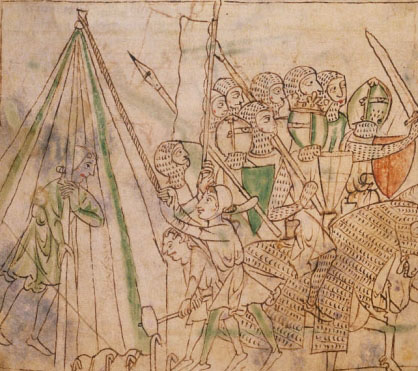
Picture showing setting up of a cone tent by using a rope attached to the top. Pegs are bent at the top and therefore must be made of iron or something similar. British Library Ms Landsdowne 782 f.34v dated to about 1240 - 1250.
Most pictures show that there is some kind of round sphere or cone at the top (propably made of wood). But this is not always the case. An illustration from a Parzival story, found at the Münchener Staatsbibliothek and dated between 1228 and 1236, shows multiple cone tents with a plain top..

Illustration from a Parzival Story (BSB Cgm 19). One can see either round spheres or cones at the top. Or a simpler variant with just plain tops. Propably created in Straßburg between 1228 and 1236. Stored in the Münchener Staatsbibliothek. Source: http://daten.digitale-sammlungen.de
I mentioned that the pole could be larger then a grown up men. Such a long pole is hard to pack in a regular car ( I wanted the pole to be about 3m long). Therefore I needed to split it up into two. But was this also done in medieval times or is this just due to me having a too small car?. I found some depiction in the “Cantigas de Santa Maria” from spain showing (propably) split poles packed and transported on a mule. The “Cantigas de Santa Maria” was written in 1280, but the depictions are from around 1284. On many pictures one can see some decoration (yellow color) at the middle of red pole.

Propably depiction of some kind of slleve (yellow color) on the red pole. From the Cantigas de Santa Maria MS T.I. 1 - Códice Rico. Dated to 1280/1284. Source: http://warfare.gq/Cantiga/Cantigas_de_Santa_Maria.htm
On another page one can see 3 of these poles wrapped up and slung onto a mule for transportation.

Depiciton of split tent poles wrapped up and slung onto a mule. From the Cantigas de Santa Maria MS T.I. 1 - Códice Rico. Folio 144r. Dated to 1280/1284. Source: http://warfare.gq/Cantiga/Cantigas_de_Santa_Maria.htm
Never the less I decided to go for a split pole instead of buying an extra long car … or felling a tree on the events.
Which manufacturer should I choose?
Since I wanted to have a hand sewn version but did not want to make it on my own (too painfull for my fingertips) I had to decide for a manufacturer. There are not many manufacturers making hand sewn cone tens. For me there where only 3 choices:
- tentorium
- I have seen many older hand sewn tents from tentorium.pl (mainly triangular tents and big pavillions) which are still in good shape despite being 10+ years old. On some of them the poles have broken over time no other problems so far. The linen is also water proof.
- matuls
- My Living-History group has bought a used big pavillion from Matuls a couple of years ago. We are very happy with it so far. But the poles where missing and we needed to build our own. Also some people I know are telling me that they have problems with the ropes drawing water into the tent. We have never experienced such an issue. All the sewing is of good quality on our big pavillion and we never needed to fix one.
- sew-mill
- One of my colleagues has cone tent from sew-mill (machine sewn). Quality of the linen is on par with the Tentorium and Matuls tents. But he needed to exchange the pole cause it broke during a heavy storm. The linen on this cone tent is water proof. But another collaegue need to impregnate his saxony tent (also from sew mill) after the first event. The sewing was not waterproof.
I decied to go for tentorium.pl cause their version was much cheaper then sew-mill. There where no pegs and wooden pole included for the Matuls version. Total price for my tent, including shipping, was ~1000€, including iron pegs and split wooden pole.
Order and delievery
I ordered the tent in march 2017 and it was delievered (like promised by Tentorium) at the end of September/beginning of October. Tentorium told me they are producing all their tents after the season.
Content of delivery
The package included everything needed to setup the tent:
- split pole made of spruce with a brass sleeve
- bent iron pegs (1 piece extra for replacement) inside a little linen bag
- linen tarpaulin
The pole has a eight-sided section and wasn’t oiled or simething else. I do not know if the linen is impregnated in some way.
There it is!
My cone tent has a diameter of ~3.6m and is about 2.6m high. There is enough space for 4 people if they donÄt have a lot of stuff. With everyone having a small chest 3 people could still fit inside.
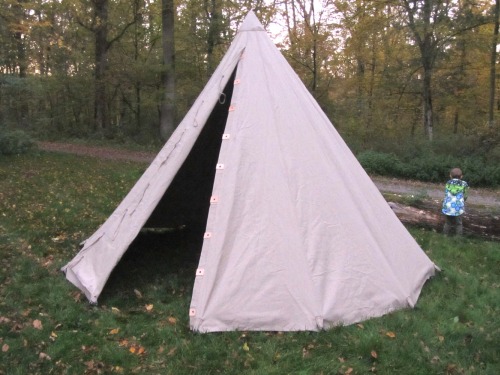
View from the side
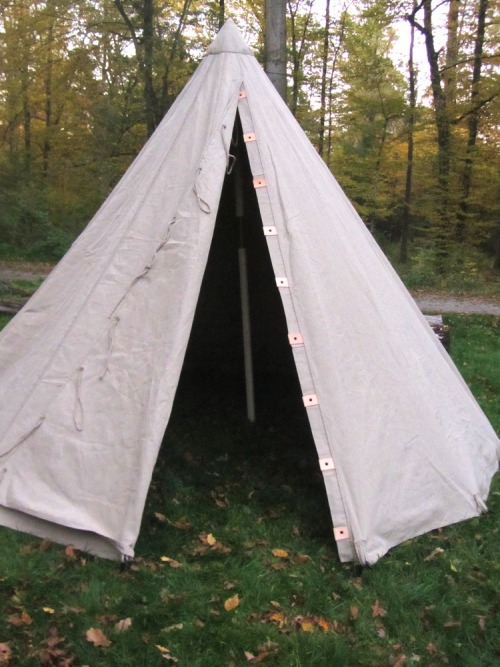
Entrance open. Pole is little bit tipped
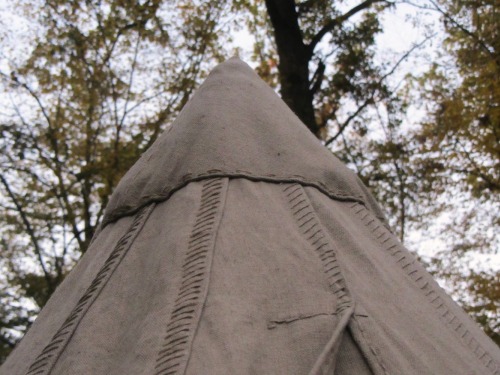
Closer look at the reinforced top
Both parts of the split pole are fiting perfectly into the brass sleeve. There is only about 0.1mm - 0.2mm space between wood and brass. The top of the pole is rounded. Therefore the linen should not wear through easily.
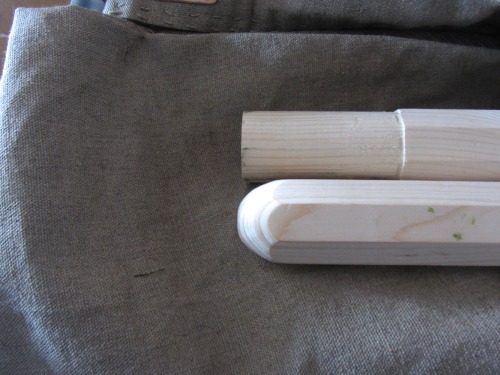
Pole with rounded top
The linen is a “fine” weave but I haven’t tested it during rain yet. I checked all the sewings and the are all done in a good and strong way. There is one detail which I really like: The loops for the pegs are attached about 5cm above the bottom. Therefore the bottom has a better contacxt to the ground preventing wind blowing through the tent.
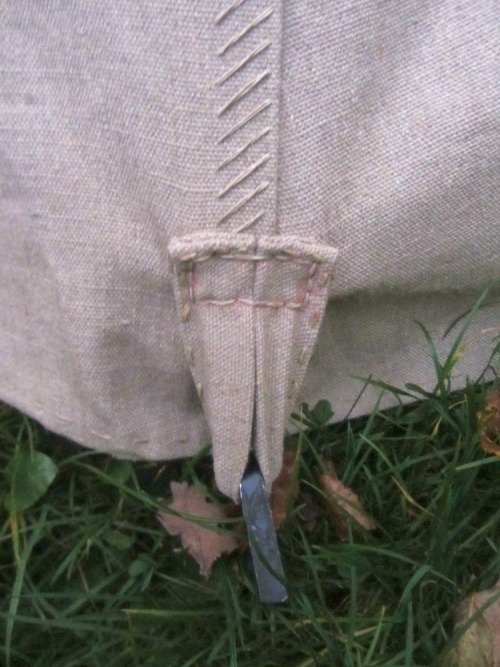
Loop with a peg about 5cm above the ground
I can completely close the entrance down to the bottom. It is closed by pulling small loops (made of rope) through each other on the inside.
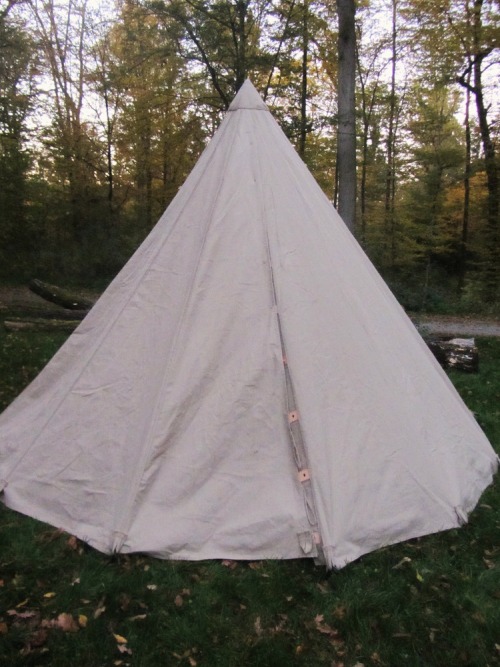
Closed tent
I will keep you update after I have tested this tent on some events.
Sources:
- Cosgrove, Sarah. A.: „Military Illustrations from Las Cantigas de Santa Maria“, unter: http://warfare.gq/Cantiga/Cantigas_de_Santa_Maria.htm (abgerufen am 06.01.2018).
- British Library Ms Landsdowne 782
- Bayerische Staatsbibliothek Cgm 19
 Adalbert Shouster
Adalbert Shouster

